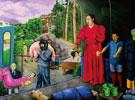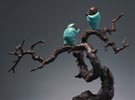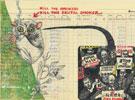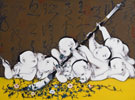My Heart Incarnated into a Butterfly
Xu Hong
“Heart” is a container, and “containing is a great virtue”, so a “containing” “heart” is infinite and unsheltered... Freedom without trace paves the way to transcend all limits of the soaring spirit. It passes through various boundaries, converges between the earth and the universe, and surpasses the bounds of honor and disgrace as well as life and death. Ancient Chinese philosophers’ ideal “to uphold the integrity of heaven and earth, and control the change of six factors in nature to reach infinite” refers to such a “free from preoccupations” state.
Qu Qianmei’s works are bitter, massive, solid and immense. Thick coal epoxy pours into the block structures that go through iron and clay, and the geometric segmentation of the picture is frank and erect, just like the resolute and severe precipices or cracked cliffs where the ridged or deep-set material surface has a strong visual tactility. It appears as if the ground was turned upside down, the smell of wet and bitter soil as well as the heavy stone clay make one feel suffocated and nervous; the deep land’s dark brown, hoary black brown, the flags’ multicolored russet brown, and crimson and gray symbolizing the supernatural power between man and spirit are all applied to form a firm and massive concept in her paintings.
These factors make Qu Qianmei’s art like a thick wide curtain, turning everyday things into hazy outlines and abstract shapes. She uses a variety of mediums to reveal the variation of constant things, and mixes up what we believe to be true or false to depict the surviving truth. In comparison with the elusiveness and intangibility described by traditional Chinese ink and wash, her paintings are poles apart! However, she uses the “reveal” technique in her art, leading audiences on a journey without earthly concerns. The artist not only shows that this is the response of religious imagination and emotions unfolding in her works with “Tibet” as the theme, she also points out that she explores these symbols to surmount the possibilities of life and manifest the “truthfully” existence of a free state. Artists should not only seek to break away from the weight of gravity so as to get the prescription to fly up to heaven, but also seek for “turning the substantial into visional” to surpass daily existence. It reveals the dialectic that humans encounter when walking on solid earth and their hearts pass through a heterogeneous space which makes clear a dilemma in striving to go beyond the earthly world and gaining transcendence by experience, this shows the hardship of never ending reciprocating searches of the spirit between sinking and sublimating. The literal meaning of Zhuangzi’s analogy “forgetting each other in this mortal life” deals with plights in reality from transcendental mentality. With deeper contemplation, we can also interpret the analogy as the spirituality of life being able to get rid of the silt and be pure and surpassing, which emphasizes that the high-spirit of danger along with mutual comfort of life and the eternal yearning for the freedom of life can exist. We can also imagine, two fish struggling on dry land while they face death and despair, although they can recall or imagine the constant free days in a river, they cannot surpass the despair to survive. However, there’s a meaningful pause in Zhuangzi’s narration, with no end for the two fish. In the void of the pause, readers can complete the ending: one, the two fish die miserably due to drying out, or second, perhaps they can swim back to the river and wait till the tide rises and the water increases. Thus things here are endowed with special meanings. Man will feel that what the fish “think” “right now” is in fact despair. What does man “think”? And man “is thinking” like a fish. Because there is a big difference between able to “think” and not “think”, namely, man and animals are dissimilar. This difference marks a dividing line between self-consciousness and fate of life, which is also the result of the contrast between man’s daily and permanent contradictions.
This kind of free-to-imagine “life and death river” belief is a constant goal in the pursuit of the spiritual character of art. Despite the different ways of pursuing “freedom” by different artists and works of art, the art for art basis is universal and is determined by man’s spiritual requirements. The length of time that artistic works stay in hearts and the depth of impression they leave are related to the degree of the expression and transcendence of pain, which are important markers that determine the spiritual quality of art and the strength of the vitality of the pieces.
The spiritual power revealed in Qu Qianmei’s art is from her life experiences, and also the explosion of spiritual rhyme from reflection. In ancient times, it was expected that a weighty body could not be reincarnated into a free “butterfly”, so the desolate life could then roam in a free world, yet the premise is the predicament of “daring not to turn over when already bumped”. Qu Qianmei’s art depicts an escape from the confinements of the reality of life, with reflection various psychological thoughts offer different life experiences, but the conversion of her spirit always carries with it the heavy print of real experiences. In her paintings, we can feel the quiver of nerve endings, the fast and slow rhythm of the heartbeat, and various moods, rain and wind, cloudy and sunny, wax and wane, or wavering... The escape from reality is in retrospect, a reflection after transcendence, and results in to “say” “to oneself” again. It is a process of leaping forward and a spiral rise, so by that looking forward and backwards, rising and falling they are forever linked. Just as man stands on earth looking up at the sky and lowering his head in thought, introspecting and inquiring to and fro. This experience of man’s spiritual situation is the starting point of Qu Qianmei’s artistic creation, and also the main clue in which the audience can grasp her artistic connotation. Her paintings contain the signs from in the real world, like the framework of building, the tracks of wheels rolling, fragments of ruins, dry trunks and chipped barks, and projection of broken debris walls. These surface material symbols constitute the basis of the painter’s art forms, so that with these clips the audiences can look for the path leading to the artist’s inner emotional world. Finally, we realize that the artist’s orientation of transcending and discovering is a “strange world” that can be expressed by form.
Qu Qianmei was nurtured by Chinese ink and wash, from the merry and lively momentum and intense atmosphere we can make out the skill training that she has always accepted. While her sensitivity to materials and a sense of proportion to paint freely without hesitation show her artistic talent. As she learns the art through the course of material conversion while also studiing art history and the techniques of classical artists. However, for artists who are passionate and have sufficient ability of control, the techniques conveyed and psychological images should be dynamically integrated. Namely, art works are not only a presentation of skills, but also an actual expression of mind and emotion. Qu Qianmei gets access to the direct and intuitive characteristics of materials to convey a forthright performance. While the forthright quality itself has the effect of directing a man’s eyes and then at man’s inner heart, in order to shake off the world’s surface to allow for the emergence of “instinct” thus forming a new relation between man and his world.
The relationship between man and materials is not to use and reconstruct materials while setting aside space so people and materials can “express” together. Namely, in the process of materials “narration”, the artist conveys this “narration” and highlights the new feelings brought about by this “narration”. The serious, careful, and many-sided feelings of materials can also be regarded as efforts made to get close to the truth. Such efforts are essentially a kind of exploration and attempt to show the willingness to be open to discovery and change - change the original persistence, unfold a new horizon and seclude the old horizon. It is the emergence of new possibilities and rising of new hope of life too. Artists view the world with a broad mind, and so present it to themselves and others.




